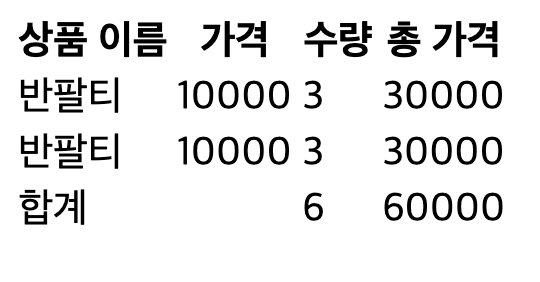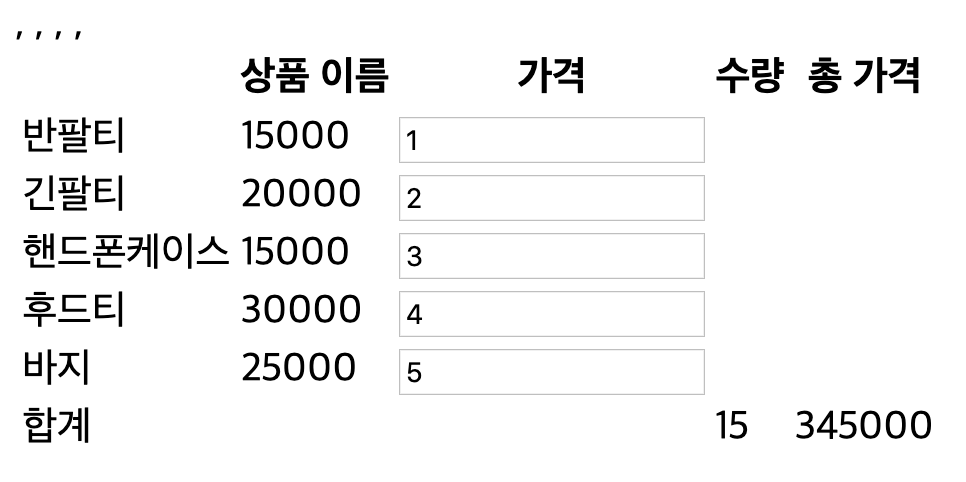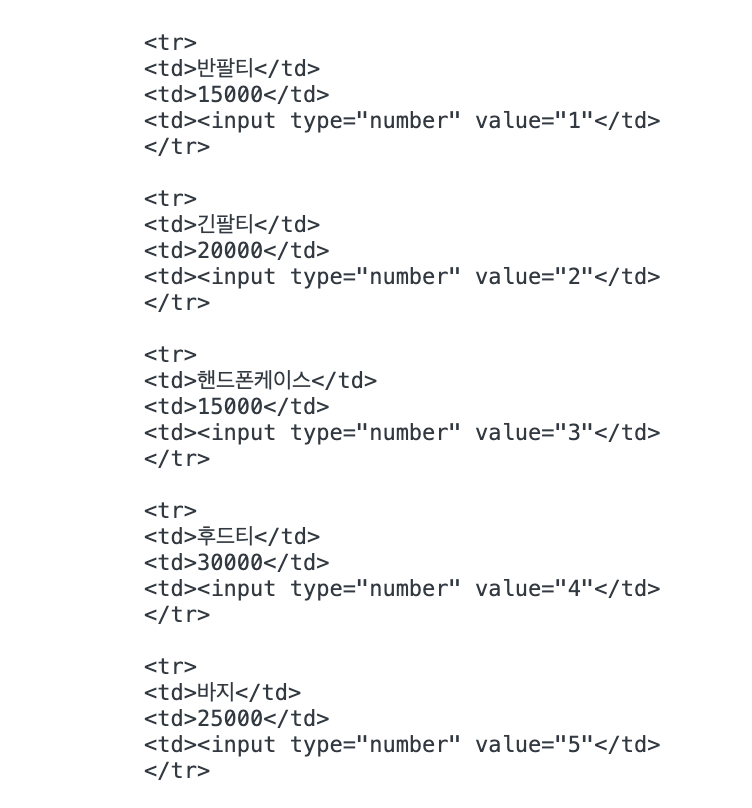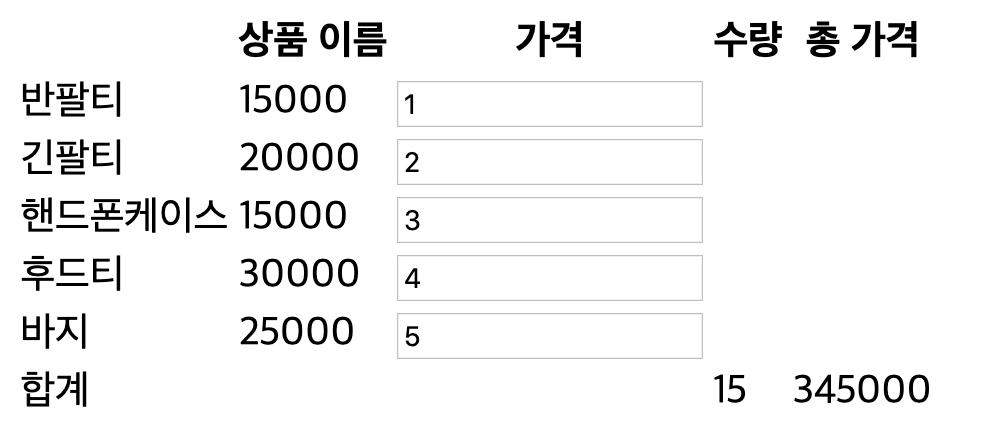함수형 프로그래밍과 JavaScript ES6+ 6. 장바구니 예시
05 Mar 2020 | javascript functional-programming ES6inflearn의 함수형 프로그래밍과 JavaScript ES6+를 보고 공부한 것을 정리합니다.
총 수량
const products = [
{ name: '반팔티', price: 15000, quantity: 1 },
{ name: '긴팔티', price: 20000, quantity: 2 },
{ name: '핸드폰케이스', price: 15000, quantity: 3 },
{ name: '후드티', price: 30000, quantity: 4 },
{ name: '바지', price: 25000, quantity: 5 },
];
const add = (a, b) => a + b;
const total_quantity = pipe(
map(p => p.quantity),
reduce(add));
log(total_quantity(products)); // 15
총 가격
const total_price = pipe(
map(p => p.quantity * p.price),
reduce(add));
log(total_price(products)); // 345000
추상화 레벨 높이기
위의 두 함수는 products라는 도메인에 대해서만 사용 가능하다. 다른 도메인에 대해서도 범용적으로 사용 가능하도록 다음과 같은 함수를 만들 수 있다.
const sum = curry((f, iter) => go(
iter,
map(f),
reduce(add)
));
위의 함수는 함수와 이터러블을 입력받아서, 해당 이터러블에 대해 함수에 맞게 추출 (map) 하고 그것에 대한 합산을 계산하는 것이다. 이를 토대로 위의 함수들은 다음과 같이 바뀔 수 있다.
const total_quantity2 = sum(p => p.quantity);
const total_price2 = sum(p => p.quantity * p.price);
log(total_quantity2(products));
log(total_price2(products));
다른 도메인에 대해서도 사용 가능하다.
log(sum(u => u.age, [
{age: 30},
{age: 20},
{age: 10}
])); // 60
sum은 이제 도메인에 구애받지 않으므로, 추상화 레벨이 훨씬 높다고 할 수 있다!
HTML로 출력하기
초기 템플릿
document.querySelector('#cart').innerHTML= '
<table>
<tr>
<th>상품 이름</th>
<th>가격</th>
<th>수량</th>
<th>총 가격</th>
</tr>
<tr>
<td>반팔티</td>
<td>10000</td>
<td><input type="number" value="3"></td>
<td>30000</td>
</tr>
<tr>
<td>반팔티</td>
<td>10000</td>
<td><input type="number" value="3"></td>
<td>30000</td>
</tr>
';
총 수량, 총 가격 추가
document.querySelector('#cart').innerHTML= '
<table>
<tr>
<th>상품 이름</th>
<th>가격</th>
<th>수량</th>
<th>총 가격</th>
</tr>
<tr>
<td>반팔티</td>
<td>10000</td>
<td><input type="number" value="3"></td>
<td>30000</td>
</tr>
<tr>
<td>반팔티</td>
<td>10000</td>
<td><input type="number" value="3"></td>
<td>30000</td>
</tr>
<tr>
<td colspan="2">합계</td>
<td>${total_quantity(products)}</td>
<td>${total_price(products)}</td>
</tr>
';

### 상품들의 목록을 출력하도록
document.querySelector('#cart').innerHTML= '
<table>
<tr>
<th>상품 이름</th>
<th>가격</th>
<th>수량</th>
<th>총 가격</th>
</tr>
<tr>
${go(products,
map(p => `
<tr>
<td>${p.name}</td>
<td>${p.price}</td>
<td><input type="number" value="${p.quantity}"</td>
</tr>
`)
)}
</tr>
<tr>
<td colspan="2">합계</td>
<td>${total_quantity(products)}</td>
<td>${total_price(products)}</td>
</tr>
';

원하는 대로 출력은 됐는데, 앞에 `````가 생겼다. 그 이유는 이것이 배열의 형태로 출력이 되었기 때문이다. log를 찍어서 확인해보면 다음과 같다.

그래서, 다음과 같이 add 코드를 추가하여 이 배열을 문자열로 만들어준다.
document.querySelector('#cart').innerHTML= '
<table>
<tr>
<th>상품 이름</th>
<th>가격</th>
<th>수량</th>
<th>총 가격</th>
</tr>
<tr>
${go(products,
map(p => `
<tr>
<td>${p.name}</td>
<td>${p.price}</td>
<td><input type="number" value="${p.quantity}"</td>
</tr>
`),
reduce(add))}
</tr>
<tr>
<td colspan="2">합계</td>
<td>${total_quantity(products)}</td>
<td>${total_price(products)}</td>
</tr>
';
그런데 위의 형태는 이전에 만들었던 sum과 같다. 그러므로 다음과 같이 바꿀 수 있다.
document.querySelector('#cart').innerHTML= '
<table>
<tr>
<th>상품 이름</th>
<th>가격</th>
<th>수량</th>
<th>총 가격</th>
</tr>
<tr>
${go(products,
sum(p => `
<tr>
<td>${p.name}</td>
<td>${p.price}</td>
<td><input type="number" value="${p.quantity}"</td>
</tr>
`))}
</tr>
<tr>
<td colspan="2">합계</td>
<td>${total_quantity(products)}</td>
<td>${total_price(products)}</td>
</tr>
';

선택된 상품들만 출력되도록
이는 장바구니이므로, 다음과 같이 선택할 수 있도록 한다.
우선 products에 is_selected 옵션을 추가한다.
const products = [
{ name: '반팔티', price: 15000, quantity: 1, is_selected: true },
{ name: '긴팔티', price: 20000, quantity: 2, is_selected: false },
{ name: '핸드폰케이스', price: 15000, quantity: 3, is_selected: true },
{ name: '후드티', price: 30000, quantity: 4, is_selected: false },
{ name: '바지', price: 25000, quantity: 5, is_selected: false },
];
document.querySelector('#cart').innerHTML= '
<table>
<tr>
<th></th>
<th>상품 이름</th>
<th>가격</th>
<th>수량</th>
<th>총 가격</th>
</tr>
<tr>
${go(products,
sum(p => `
<tr>
<td><input type="checkbox" ${p.is_selected ? 'checked' : ''}></td>
<td>${p.name}</td>
<td>${p.price}</td>
<td><input type="number" value="${p.quantity}"</td>
</tr>
`))}
</tr>
<tr>
<td colspan="2">합계</td>
<td>${total_quantity(filter(p => p.is_selected, products))}</td>
<td>${total_price(filter(p => p.is_selected, products))}</td>
</tr>
';


Comments